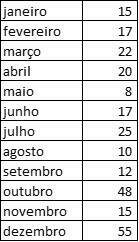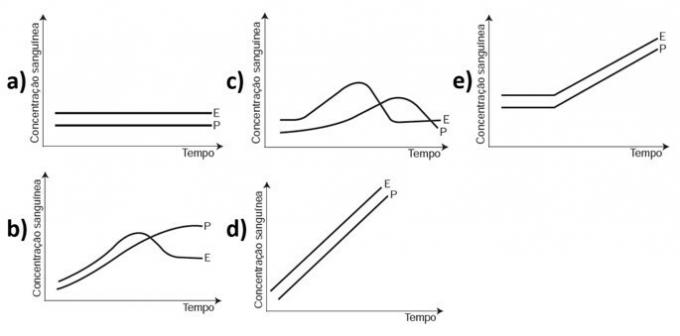Study and answer your questions about standard deviation with the exercises answered and explained.
question 1
A school is organizing an Olympics where one of the tests is a race. The times it took five students to complete the test, in seconds, were:
23, 25, 28, 31, 32, 35
The standard deviation of the students' test times was:
Answer: Approximately 3.91.
The standard deviation can be calculated by the formula:
Being,
∑: summation symbol. Indicates that we have to add all the terms, from the first position (i=1) to the n position
xi: value at position i in the dataset
MA: arithmetic mean of the data
n: amount of data
Let's solve each step of the formula separately, to make it easier to understand.
To calculate the standard deviation, it is necessary to calculate the arithmetic mean.
We now add the subtraction of each term by the mean squared.
We divide the value of this sum by the number of elements added.
Finally, we take the square root of this value.
question 2
The same assessment was applied to four groups with different numbers of people. The minimum and maximum scores for each group are shown in the table.

Considering the average of each group as the arithmetic mean between the minimum and maximum grade, determine the standard deviation of the grades in relation to the groups.
Consider up to the second decimal place, to simplify the calculations.
Answer: approximately 1.03.
The standard deviation can be calculated by the formula:
As the quantities are different in each group, we calculate the arithmetic mean of each one, then weight it between the groups.
Arithmetic averages
Weighted average between groups
Term calculation:
, where xi is the mean of each group.
Dividing the sum value by the number of groups:
Taking the square root
question 3
In order to implement quality control, an industry that produces padlocks monitored its daily production for a week. They recorded the number of defective padlocks produced each day. The data were as follows:
- Monday: 5 defective parts
- Tuesday: 8 defective parts
- Wednesday: 6 defective parts
- Thursday: 7 defective parts
- Friday: 4 defective parts
Calculate the standard deviation of the number of defective parts produced during that week.
Consider up to the second decimal place.
Answer: Approximately 1.41.
To calculate the standard deviation, we will calculate the average between the values.
Using the standard deviation formula:
question 4
A toy store surveyed the company's revenue over the course of a year and obtained the following data. in thousands of reais.

Determine the standard deviation of the company's revenue this year.
Answer: approximately 14.04.
Calculating the arithmetic mean:
Using the standard deviation formula:
To calculate the sum:
Adding all the installments we have 2366.
Using the standard deviation formula:
question 5
Research is being carried out with the aim of knowing the best variety of a plant for agricultural production. Five samples of each variety were planted under the same conditions. The regularity in its developments is an important feature for large-scale production.
Their heights after a certain time are below, and the plant variety with greater regularity will be chosen for production.
Variety A:
Plant 1: 50 cm
Plant 2: 48 cm
Plant 3: 52 cm
Plant 4: 51 cm
Plant 5: 49 cm
Variety B:
Plant 1: 57 cm
Plant 2: 55 cm
Plant 3: 59 cm
Plant 4: 58 cm
Plant 5: 56 cm
Is it possible to arrive at a choice by calculating the standard deviation?
Answer: It is not possible, as both varieties have the same standard deviation.
Arithmetic mean of A
standard deviation of A
Arithmetic mean of B
standard deviation of B
question 6
In a certain audition for a role in a play, two candidates entered and were evaluated by four judges, each of whom provided the following marks:
Candidate A: 87, 69, 73, 89
Candidate B: 87, 89, 92, 78
Determine the candidate with the highest mean and lowest standard deviation.
Answer: Candidate B had the highest mean and lowest standard deviation.
Candidate A average
Candidate B average
standard deviation of A
standard deviation of B
question 7
(UFBA) During a working day, a pediatrician assisted, in his office, five children with symptoms compatible with the flu. At the end of the day, he produced a table with the number of days that each of the children had a fever, before the appointment

Based on these data, it can be stated:
The standard deviation for the number of fever days for these children was greater than two.
Right
Wrong
Calculation of the arithmetic mean.
Standard deviation
question 8
(UNB)

The graph above shows the number of hospitalizations of drug users up to 19 years old, in Brazil, from 2001 to 2007. The average number of hospitalizations in the period, indicated by the bold line, was equal to 6,167.
Check the option that presents the expression that allows you to correctly determine the standard deviation — R — of the data series indicated in the graph.
The)
B)
w)
d)
Calling the standard deviation R:
Squaring the two terms:
Being n equal to 7, it passes to the left by multiplying R².
Thus, we see that the only possible alternative is the letter a, as it is the only one in which the R appears raised to the square.
question 9
(Enem 2019) An inspector from a certain bus company records the time, in minutes, that a novice driver spends to complete a certain route. Table 1 shows the time spent by the driver on the same journey seven times. Chart 2 presents a classification for the variability over time, according to the standard deviation value.

Based on the information presented in the tables, the time variability is
a) extremely low.
b) low.
c) moderate.
d) high.
e) extremely high.
To calculate the standard deviation we need to calculate the arithmetic mean.
Standard deviation calculation
As 2 <= 3.16 < 4, the variability is low.
question 10
(Enem 2021) A zootechnician intends to test whether a new rabbit feed is more efficient than the one he is currently using. The current feed provides an average mass of 10 kg per rabbit, with a standard deviation of 1 kg, fed this feed over a period of three months.
The zootechnician selected a sample of rabbits and fed them the new feed for the same period of time. At the end, he wrote down the mass of each rabbit, obtaining a standard deviation of 1.5 kg for the distribution of the masses of the rabbits in this sample.
To assess the efficiency of this ration, he will use the coefficient of variation (CV) which is a measure of dispersion defined by CV = , where s represents the standard deviation and
, the average mass of the rabbits that were fed a given feed.
The zootechnician will replace the feed he has been using for the new one, if the coefficient of variation of the mass distribution of the rabbits that were fed the new feed is less than the coefficient of variation of the mass distribution of the rabbits that were fed the feed current.
The replacement of the ration will occur if the mean of the mass distribution of the rabbits in the sample, in kilograms, is greater than
a) 5.0
b) 9.5
c) 10.0
d) 10.5
e) 15.0
current ration
- Average mass of 10 kg per rabbit (
)
- 1kg standard deviation
new feed
- unknown mean mass
- Standard deviation of 1.5 kg
condition for replacement
learn more about standard deviation.
See too:
- Variance and standard deviation
- Statistics - Exercises
- Mean, Mode and Median Exercises
ASTH, Rafael. Standard Deviation Exercises.All Matter, [n.d.]. Available in: https://www.todamateria.com.br/exercicios-de-desvio-padrao/. Access at:
See too
- Variance and standard deviation
- Statistics - Exercises
- Dispersion Measures
- Arithmetic Mean Exercises
- Mean, Mode and Median Exercises
- Standard deviation
- Statistic
- Weighted Arithmetic Mean


